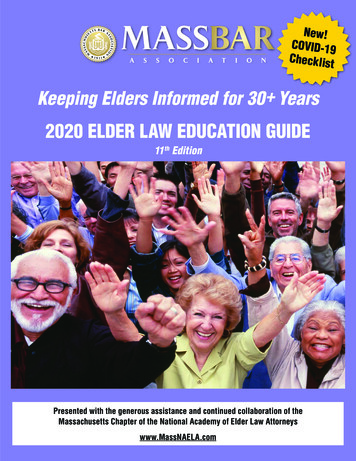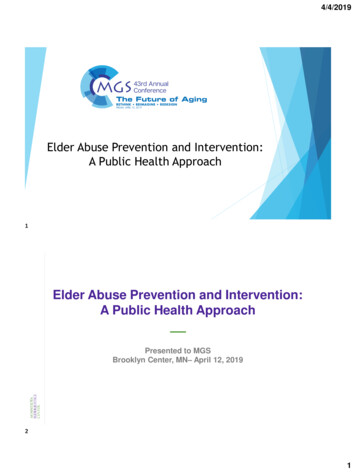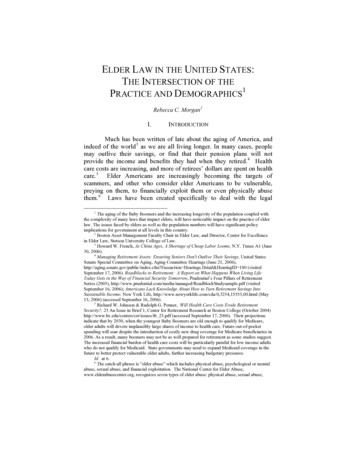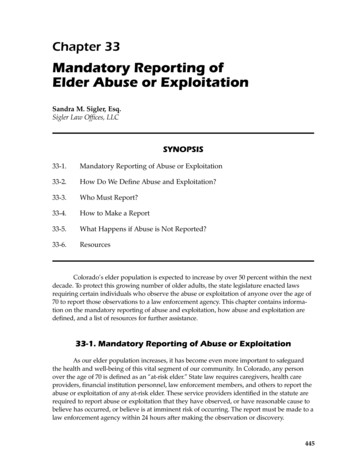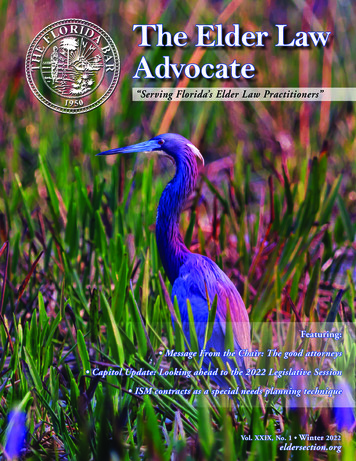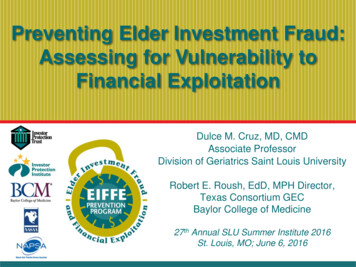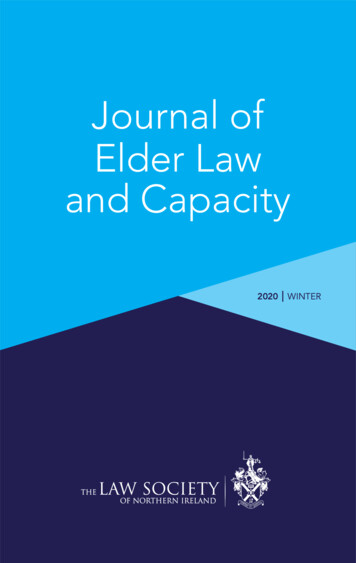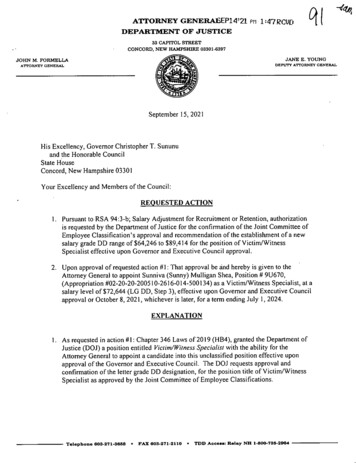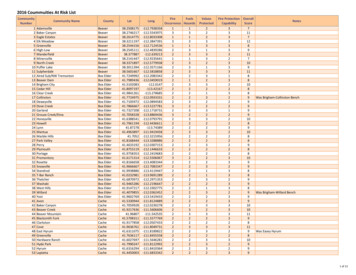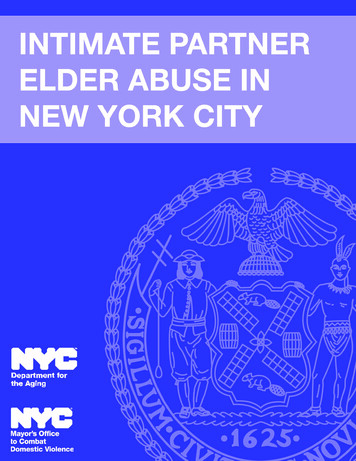
Transcription
Legal Basics: Elder Financial ExploitationCHAPTER SUMMARY January 2018Charles P. Sabatino, ABA Commission on Law and Aging1American Bar Association Commission on Law and AgingThe mission of the American Bar Association Commission on Law and Aging (ABA Commission) is to serveas the collaborative, interdisciplinary leader of the Association’s work to strengthen and secure the legal rights,dignity, autonomy, quality of life, and quality of care of aging persons, particularly low-income and vulnerableelders. Since 1979, the ABA Commission has carried out this mission through research, policy development,technical assistance, advocacy, education, and training.Key Lessons1. There are many different types of financial exploitation. Financial exploitation is costly, devastating, andusually unreported.2. It is important to observe and screen for common characteristics of victims and perpetrators ofexploitation.3. Several legal action strategies are available to attorneys to prevent, intervene, and redress financialexploitation.4. Take advantage of systems change opportunities. No one entity is fully capable of preventingthe problem or meeting the needs of victims. Each has a crucial role to play, and interaction andcollaboration among resources and stakeholders is necessary.Section 1: Definition & Types of Financial ExploitationFinancial exploitation is one form of elder abuse.2 Federal and state laws use a myriad of definitions, anddifferent categories within those definitions, for elder abuse and financial exploitation. Financial exploitation isdefined in the Older Americans Act as:“The fraudulent or otherwise illegal, unauthorized, or improper act or process of an individual, including acaregiver or fiduciary, that uses the resources of an older individual for monetary or personal benefit, profit,or gain, or that results in depriving an older individual of rightful access to, or use of, benefits, resources,belongings, or assets.”3Similarly, the National Research Council and the Government Accountability Office4 define “unjust,improper, and/or illegal use of another’s resources, property, and/or assets” as financial exploitation.At the state level, legislative definitions vary. State law civil and criminal definitions of financial abuse orexploitation can be found through the Department of Justice Elder Rights Initiative website.512345The author thanks his colleague Lori Stiegel for the use of portions of her materials.For more Legal Basics information on Elder Abuse, see: .pdf.42 U.S.C.A. § 3002.Bonnie, Wallace R. Elder Mistreatment: Abuse, Neglect, and Exploitation in an Aging America. National Research Council(U.S.). Washington: National Academies Press (2003).U.S. Department of Justice, Elder Rights Initiative. See tatutes (last visitedDecember 22, 2017).
Chapter Summary2Research and professional anecdotes indicate that elder abuse victims usually experience multiple types ofabuse; this may be referred to as “polyvictimization.”6Types of financial exploitationThere are differing ways of categorizing types of financial abuse and exploitation, and the boundariesbetween them can be blurry, but one simple distinction divides financial exploitation into two types: those by a“known” person and those by a “stranger”: Known person: Financial abuse/exploitation by a known person (a family member, close friend,caregiver, or person/organization in a position of trust) who breaches the trust of a vulnerable personand misuses the individual’s funds to serve their own needs at the elder’s expense. Remedies for thesekinds of abuse are generally civil and possibly criminal. Stranger or “new friend”: Fraud, misrepresentation, or scams by a stranger or “new friend” whodeceives the vulnerable person via an ever-changing variety of con games, such as bogus lotteries,sweetheart swindles, grandparent scams, fake charities, home repair fraud, IRS back taxes schemes,identity theft, etc. These are generally all criminal forms of abuse.A 2015 study by True Link Financial breaks out a subset of the fraud and misrepresentation category aboveof exploitation that is done openly with the claimed consent of the victim and involved matters such as hiddenshipping and handling or subscriptions; work-from-home schemes; and quack weight loss or dietary products orother dubious sales.7 This might be thought of as snake oil salesman abuse and may or may not rise to the levelof criminal fraud.Institutional abuse in long-term care settings pose uniquely different challenges and is often categorizedseparately. Nursing home and institutional abuse is outside the focus of this Chapter Summary.The extent of financial exploitationFinancial exploitation of older adults is a prevalent and underreported problem. The National ElderMistreatment Study by Ron Acierno and colleagues surveyed a national sample of community-residing,cognitively intact, adults aged 60 years and older in 2008. The study found that over 11% of respondentsreported experiencing some type of abuse or potential neglect in the past year, with the most frequent form ofmistreatment noted being financial exploitation by family members (5.2%).8 This is likely a low estimate sincethose with cognitive impairments, no phone, or who are living in facilities were excluded. Other studies haveshown slightly lower levels, but limited samples and methodologies have made precise data elusive.A 2011 Federal Trade Commission survey of the prevalence of scams and fraud in the U.S. found that 7.3%of adults 65-74 and 6.5% of adults 75 and older were victims. Another factor making good data hard to comeby is underreporting of elder abuse of all forms: only 1 in 5 cases9 to 1 in 23 cases is reported.1067Pamela B. Teaster, “A Framework for Polyvictimization in Later Life,” 29(5) J. Elder Abuse & Neglect 289 (2017).True Link Financial, The True Link Report on Elder Financial Abuse 2015, cial-Abuse-012815.pdf. (last visited December 22, 2017).8 Acierno R, Hernandez MA, Amstadter AB, Resnick HS, Steve K, Muzzy W, Kilpatrick DG. “Prevalence and Correlates ofEmotional, Physical, Sexual, and Financial Abuse and Potential Neglect In the United States: The National Elder MistreatmentStudy. 100 AM J Public Health 292-7 (2010).9 National Center on Elder Abuse. The National Elder Abuse Incidence Study, Final report to the Administration on Children andFamilies and Administration on Aging, U.S. Department of Health and Human Services, Grant No. 90–AM–0660 (1998).10 Lifespan of Greater Rochester, Inc., Weill Cornell Medical Center of Cornell University & New York City Department for theAging, Under the Radar: New York State Elder Abuse Prevalence Study (2011).
Chapter Summary3The cost of elder financial exploitationFinancial exploitation is enormously costly to a victim’s health and economic security. Studies estimate thefinancial loss due to exploitation in the billions of dollars. A 2010 MetLife study examined news and mediaarticles about elder financial exploitation and estimated annual financial losses to seniors at approximately 2.9billion.11 Yet, a 2014 survey of Americans aged 50–70 by True Link Financial estimated annual losses at a muchhigher 36.5 billion.12For elder abuse in general, multiple studies have shown that elder abuse increases a victim’s risk ofhospitalization by three times, nursing home admission by four times, and mortality by three times.13 Advocatesfor older adults know that elder abuse also may cause impoverishment and the need to rely on governmentbenefit programs (although financial exploitation also may lead to Medicaid penalties),14 as well as homelessnessor involuntary co-housing.Section 2: Victim and Perpetrator Characteristics and ScreeningAttorneys working with older adult clients should become familiar with the characteristics of victims whomay be at risk for financial exploitation. Factors that have been shown to increase the risk of being a victim ofabuse in general include: age, female gender, cognitive impairment, physical impairments, depression, loneliness,substance abuse, and social isolation.15Perpetrators of abuse are predominantly family members or another person in a relationship of trust andmore likely to be younger than the victim. “Relationship of trust” is a term commonly used to describe therelationship an older adult has with intimate partners, relatives, paid or unpaid caregivers, friends, neighbors,and fiduciaries such as agents under a power of attorney, trustees, guardians, or conservators. Factors thatincrease the likelihood of being a perpetrator include caregiver burden, depression, substance abuse, and othermental health issues, and a lack of social supports.16The victim-perpetrator relationship tends to make it very difficult for victims to rectify their circumstanceor seek help. Victims may not recognize the exploitation. They may fear retaliation, disbelief by others, orthe stigma of victimization. They may depend on the perpetrator for all or most of their needs. They maybe reluctant to get perpetrator in trouble, or worse, fear that the result will be their own placement underguardianship or in a nursing home.In addition to characteristics, attorneys should also be aware of different situations that may indicate the riskor occurrence of financial exploitation. These common indicators include:Financial changes: Banking inconsistent with elder’s ability and past history Unusual ATM use or wiring of money11 The MetLife Mature Market Institute, et al., The MetLife Study of Elder Financial Abuse: Crimes of Occasion, Desperation, andPredation Against America’s Elders (June 2011). s/studies/2011/mmi-elderfinancial-abuse.pdf. (last visited December 22, 2017).12 True Link, The True Link Report on Elder Financial Abuse 2015 1, ncial-Abuse-012815.pdf (last visited December 22, 2017).13 Marie-Therese Connolly, et al., The Elder Justice Roadmap, A Stakeholder Initiative to Respond to an Emerging Health, Justice,Financial and Social Crisis 3 (2014), urces/EJRP Roadmap.pdf. (last visitedDecember 22, 2017).14 See Elder Financial Abuse and Medicaid Denials, (2017), available at: dMedicaid-Denials.pdf.15 Ruijia Chen and XinQi Dong, “Risk Factors of Elder Abuse,” in XinQi Dong (ed.), Elder Abuse: Research, Practice and Policy(2017).16 Id.
Chapter Summary Changed or missing financial documents Failing to pay bills normally paid4Document and property changes: Forged or suspicious signature on documents Missing property Failure to remember or understand recent transactionsPersonal and relationship changes: Lack of previously enjoyed necessities or amenities Recent, new “best friends” or “sweethearts” Isolation due to actions by others Changes in elder’s appearance, mood, habits Being accompanied by a coercive other personScreening tools for abuse and neglect have a scattered and limited history.17 There is no proven standard forelder abuse screening. Of tools that exist, a majority are designed for use by health care providers. In all cases,a positive screening for elder abuse means that further information should be gathered. It’s not conclusive thatelder abuse is occurring.Beyond screening, there are some practical tools that enable advocates to collect relevant information in apractical way and identify red flags that help determine whether further investigation is necessary: Since diminished capacity is an important risk factor for exploitation, it is important to have a systemin place to screen all clients for capacity issues. A Handbook by the American Bar Association andAmerican Psychological Association titled, Assessment of Older Adults with Diminished Capacity:A Handbook for Lawyers (2005) includes in-depth guidance and a 4-page worksheet to screen forincapacity.18 The Investor Protection Trust (IPT) and its collaborators developed a handy Pocket Guide on ElderInvestment Fraud and Financial Exploitation (EIFFE) for clinicians that is instructive for a wideraudience of professionals.19 The ABA Commission on Law and Aging collaborated with IPT to develop an EIFFE training forlawyers to identify and respond ethically and effectively to exploitation. The project’s 2-page Checklistfor Lawyers is included as an Appendix to this Chapter Summary. The Consumer Financial Protection Bureau series of booklets Managing Someone Else’s Money, allinclude lists of common signs for financial exploitation and consumer scams.20 Undue Influence often fuels financial exploitation. It can occur even when the elder’s decision-makingcapacity appears quite intact. While state law definitions and standards for undue influence vary17 Margot J. Schofield, “Screening for Elder Abuse: Tools and Effectiveness,” in XinQi Dong (ed.), Elder Abuse: Research, Practice andPolicy (2017).18 Assessment of Older Adults with Diminished Capacity: A Handbook for Lawyers (2005), available at https://www.americanbar.org/groups/law aging/resources/capacity assessment.html19 Pocket Guide on Elder Investment Fraud and Financial Exploitation, available at: a eiffe-pp20 Managing Someone Else’s Money, Consumer Financial Protection Bureau, available at: ging-someone-elses-money.
Chapter Summary5widely, their themes are similar. The California Undue Influence Screening Tool, developed by the CaliforniaElder Justice Coalition, can be useful for any advocate as a starting point for undue influence assessment inany state.21PRACTICE TIP: Client InterviewsIt is beneficial to ask all clients about whether they have any financial management concerns. Attorneysshould determine who the client is, if it is not obvious, and interview the client alone. During the clientinterview, first explain that you (the attorney) ask clients these questions because you need to know aboutall issues affecting their case to provide competent representation. Next, if you practice in a state thatmandates lawyers to report suspected financial exploitation to Adult Protective Services (APS), explain yourethical and legal responsibilities and their potential implications. It is useful to develop a thoughtful scriptfor introducing the topic and initial questions, as it is easier for clients to answer questions than volunteerinformation. Even if the client chooses not to discuss certain issues, they have an opening to return forfuture help.Section 3: Action StepsThere are steps lawyers can take to help prevent financial exploitation and protect clients.PreventionLawyers can help prevent elder abuse in multiple ways, before and after problems are detected. Preventionactivities include: educating older adults and other professionals through presentations and materials; counselingclients about vulnerability; connecting clients to needed health or social services; and recommending that clientstake steps to minimize the risk of abuse and facilitate its detection, such as by limiting the use of joint bankaccounts or including oversight provisions in powers of attorney, supported decision-making agreements, ortrusts.PRACTICE TIP: Prevention and Powers of AttorneyPowers of Attorney (POA) are especially susceptible to being abused since they can confer broad powerswith no supervision. Abuse can occur in their creation because of the principal’s incapacity, or by forgery ormisrepresentation, or undue influence. Even when voluntarily and competently executed, abuse can occurlater where the agent’s authority is exceeded, or the agent engages in self-dealing or in transactions thatcontravene the principal’s expectations.While power of attorney drafting is a topic beyond the scope of this summary, a few drafting tips that candecrease the likelihood of financial exploitation are highlighted here for consideration in drafting any POA:require annual accountings to a third person or persons; require a second signature for large transactions;and grant a power to revoke to a 3rd person.It is also important to limit “hot powers,” those that can substantially change or undermine a person’sfinancial goals and plans. The Uniform Power of Attorney Act22 identifies these as powers to: make a gift(including limitations on amounts and beneficiaries); create or change rights of survivorship; create orchange a beneficiary designation; create, amend, revoke, or terminate a trust; delegate agent’s authority;waive principal’s rights under a joint and survivor annuity, including survivor benefits under a retirementplan; and disclaim property, including a power of appointment.21 California Undue Influences Screening Tool, available at: available at http://www.elderjusticecal.org/blueprint.html.22 Uniform Law Commission, Uniform Power of Attorney Act (2006). Available at http://www.uniformlaws.org/Act.aspx?title Power%20of%20Attorney. (last visited December 22, 2017).
Chapter SummaryReportingAPS laws in every state, except New York, require mandatory reporting about suspected elder abuse toAPS by some professionals and providers in some circumstances. A growing number of APS laws also requirereporting to law enforcement or some other agency under more limited circumstances. Lawyers are mandatoryreporters in some states, either because they are specifically listed as reporters or because the APS law requireseveryone to report. In addition, other federal and state laws may mandate reporting to other agencies.23Professionals need to assess their reporting obligations and ethical duties, and then counsel clients aboutconfidentiality during initial interviews and subsequently if necessary.ProtectionAfter abuse occurs, or after abuse is suspected, lawyers can use legal tools to protect an elder abuse victimfrom further harm. These legal actions may include: Revoking legal documents Obtaining a separation or divorce for the client Petitioning for protection orders or injunctions Bringing eviction or other removal proceedings against an abuser Petitioning for, opposing, limiting, or terminating appointment of a guardian or conservator who is aperpetratorRedressMany civil actions are possible against an abuser and require state-specific research to determine theirappropriateness, feasibility, standards, and procedures. They all open up certain challenges as remedies forfinancial exploitation. Judicial procedures may be cumbersome and subject to delays. Evidence and witnessesmay be unavailable, and your client may lack capacity to testify. Proving a lack of capacity at earlier points intime may be difficult, and proving undue influence takes considerable indirect evidentiary development. Thevictim may lack the resources for a judicial battle, and most serious of all, the perpetrator may lack money forrestitution. Nevertheless, thorough investigation and good lawyering can overcome many of the obstacles.Civil actions to rectify elder abuse may include: Seeking an accounting Rescinding transfers or voiding documents due to fraud, incapacity, or undue influence Breach of contract Breach of fiduciary duty Constructive trusts Conversion Fraud Rescission Restitution In a few jurisdictions, a private right of action for elder abuse23 See National Adult Protective Services Association, 1/MandatoryReporting-Chart-Updated-FINAL.pdf.6
Chapter Summary7Historically, criminal remedies have been underutilized. But recent years have brought an increasingrecognition of financial exploitation as a crime, with increased involvement of law enforcement and prosecutors.Legislatures are strengthening laws and penalties for abuse against elders, and public court systems are reexamining their own procedures and community connections. While this is all good news, the field is still in agerminal stage.Section 4: System Change OpportunitiesNumerous systems address elder abuse. These include but are not limited to: Adult Protective Services; Aging and Disability Services: long-term services and supports, long-term care ombudsman program,protection and advocacy programs; Civil Justice System: legal aid programs, private practitioners, pro bono programs, alternative disputeresolution services, guardians, state Attorneys General; Criminal Justice System: law enforcement; crime victim services; prosecutors—local, state (MedicaidFraud Control Units, Attorneys General), federal (U.S. Attorneys, U.S. Department of Justice);community corrections (pre-trial, probation, parole); coroner/medical examiner; Federal Agency Benefit Programs (e.g., Social Security Administration, Veterans Administration); Financial Services Industry and Regulators; Health Care and Mental Health Care Systems and Regulators; Housing services; Judicial Systems: traditional courts; problem-solving courts such as elder protection courts or familyviolence courts; court programs such as elder justice centers or self-help centers; and Victim Services, Elder Abuse Multidisciplinary Teams, and advocacy coalitions.No one system can meet all of a victim’s needs. Therefore, in addition to providing direct services to victims,advocates need to learn more about other systems and engage them in finding solutions to systemic elder abuseissues.ConclusionElder financial exploitation takes many forms, is widespread, and is often intertwined with other forms ofabuse and neglect. Financial exploitation has devastating consequences for victims, and is very costly to victims’families, businesses, and taxpayers. As victims rarely report elder abuse, law and aging network programs need tointerview clients effectively and take steps to provide services competently and safely. Civil lawyers can play anespecially effective role in preventing, identifying, and responding to financial exploitation on both an individualand systems level.Additional Resources Lori Stiegel, lori.stiegel@americanbar.org Key Statutes Governing Elder Abuse»» Elder Justice Act, 42 U.S.C. § 1397j et seq. and 42 U.S.C. § 1320b-25»» Older Americans Act of 1965, as amended, 42 U.S.C. § 3001 et seq.»» Elder Abuse Prevention and Prosecution Act, PL 115–70 [S 178], approved October 18, 2017.»» State Adult Protective Services Laws
Chapter Summary Key Federal Regulations Related to Elder Abuse»» Long-Term Care Ombudsman Program Regulations 45 CFR Parts 1321 and 1327 Key Federal Agencies Addressing Elder Abuse»» U.S. Administration for Community Living, Department of Health and Human Services,www.aoa.acl.gov»» Consumer Financial Protection Bureau, www.consumerfinance.gov/older-americans»» The Federal Trade Commission, www.ftc.gov»» U.S. Department of Justice Elder Justice Initiative, www.justice.gov/elderjustice National Institute of Justice, .aspx Office for Victims of Crime, www.ojp.usdoj.gov/ovc Office on Violence Against Women, www.justice.gov/ovw Select National Entities Providing Additional Resources»» American Bar Association Commission on Law and Aging, www.americanbar.org/aging»» National Center on Elder Abuse, www.ncea.acl.govCase consultation assistance is available for attorneys and professionals seeking more information tohelp older adults. Contact NCLER at ConsultNCLER@acl.hhs.gov.This Chapter Summary was supported by a contract with the National Center on Law and Elder Rights, contractnumber HHSP233201650076A, from the U.S. Administration for Community Living, Department of Health andHuman Services, Washington, D.C. 20201.8
Elder Investment Fraud and Financial Exploitation: Checklist for LawyersCommission onLaw and AgingScreen all older clients about whether they are experiencinginvestment fraud and financial exploitation because: Victims often will not disclose their situation voluntarilybut they will do so if asked; Establishing the practice of asking all clients reducesthe stigma felt by the victim and helps you feel morecomfortable about asking sensitive questions; and Questions that demonstrate an awareness of the issueindicate to clients that they can seek help from you inthe future if they are not ready or able to do so now.Be aware of red flags in client history: Social isolation Bereavement Client’s dependence on possible exploiter(for care, financial support, housing, companionship) Possible exploiter’s dependence on client(for care, financial support, housing, companionship) Alcohol or drug abuse Depression or mental illnessBefore asking older clients about investment fraud andfinancial exploitation as part of their initial interview: Determine who your client is, if it is not obvious; Interview your client alone; Explain that you ask clients these questions becauseyou need to know about all issues affecting their case toprovide competent representation; and Explain your ethical and legal responsibilities andtheir potential implications if you practice in a statethat mandates lawyers to report suspected financialexploitation to adult protective services.National resources for additional information: Investor Protection Trust, www.investorprotection.org American Bar Association Commission on Law andAging, www.americanbar.org/aging North American Securities Administrators Association,www.nasaa.org National Adult Protective Services Association(to find APS agencies), www.napsa-now.org Eldercare Locator (to find state and local aging anddisability services), www.eldercare.govClient Background:Client Name:See Possible Indicators on Next Page and Make Notes Here:Attorney(s)/Interviewer(s)Name(s):Date, Time, andPlace of Interview:If Another Person is Present During Interview, DescribeWho, Relationship to Client, and Why: 2017 by the Investor Protection Trust. These materials were developed as part of the Elder Investment Fraud and Financial Exploitation Prevention Programin collaboration between the American Bar Association Commission on Law and Aging and the Investor Protection Trust (IPT). The IPT hereby grants permissionfor copies of the materials herein to be made, in whole or in part, for law firm use, for classroom use in an institution of higher learning, or for use by not-forprofit organizations including bar associations, provided that the use is for non-commercial purposes only and any copy of the materials or portion thereofacknowledges original publication by the IPT in collaboration with the ABA Commission on Law and Aging, including the title of the publication, and the legend“Reprinted by permission of the Investor Protection Trust. All rights reserved.” Requests to reproduce portions of this publication in any other manner shouldbe emailed to iptinfo@investorprotection.org. Learn more about the Elder Investment Fraud and Financial Exploitation Program www.investorprotection.org.
Reported Reported Observedby Client by Other by LawyerPossible IndicatorsAccompaniment by a stranger, family member or other person especially if they seem toprevent self-expression or decision-making, or to coerce decisions or transactionsAccusations that caregivers, family members, or others are taking or mismanaging assetsBanking activity that is erratic, uncharacteristic, or inconsistent with abilityCarrying financial documents around in bags all the timeChanges in appearance, grooming, hygiene, mood, patterns of eye contactChanges in property titles, will, or other documents, particularly if the person isconfused and/or the documents favor new acquaintancesConcern or confusion about missing funds or propertyConfusion about executing or having executed a power of attorneyExpressions of fear, such as cringing or withdrawingFearful of eviction, institutionalization, or abandonment if money or other assets are notgiven to caregiver or othersFrequently forgetting or claiming to have forgotten ATM card, checkbook, deposit slips,or other items needed for financial transactionsHesitance to enter into or engage in conversationImplausible explanations about what is being done with money or propertyLack of awareness or understanding of recently completed financial transactionsExcessive contacts by telemarketersFacing eviction or discontinuation of utility servicesFailure to receive services for which payment has been madeForged or suspicious signature on documentsIsolation by othersLack of care for the individual or residence when arrangements have been made forproviding personal care or home maintenance servicesLack of seemingly affordable necessities or amenitiesMissing documents related to accounts, pensions, stock, government payments, etc.New acquaintances, particularly those who have moved in to residenceSigns of excessive or unauthorized trading of investment fundsSuddenly stopped receiving mail, particularly billsSuspicious activity on credit card or other financial accountsUnsuitable investments due to level of risk or age of clientScreening Questions should be direct, but not conclusive. Asking clients if they have been exploited or defrauded is not usefulif clients do not understand or relate their experiences to those terms. Start with general questions and then turn some of thepossible indicators into questions. Delve deeper if appropriate. Who makes decisions about yourmoney and property? How is thatgoing? How do you get cash when you needit? Any problems with that? Does anyone have access to yourbank account? How is that going? Have you noticed any suspicious orunusual items on your bills? Have you noticed money missingfrom your bank accounts or checksmissing from your checkbook? Are any of your belongings missingfrom your home? Have you signed documents thatyou did not understand or want tosign because
For elder abuse in general, multiple studies have shown that elder abuse increases a victim's risk of hospitalization by three times, nursing home admission by four times, and mortality by three times. 13. Advocates for older adults know that elder abuse also may cause impoverishment and the need to rely on government
